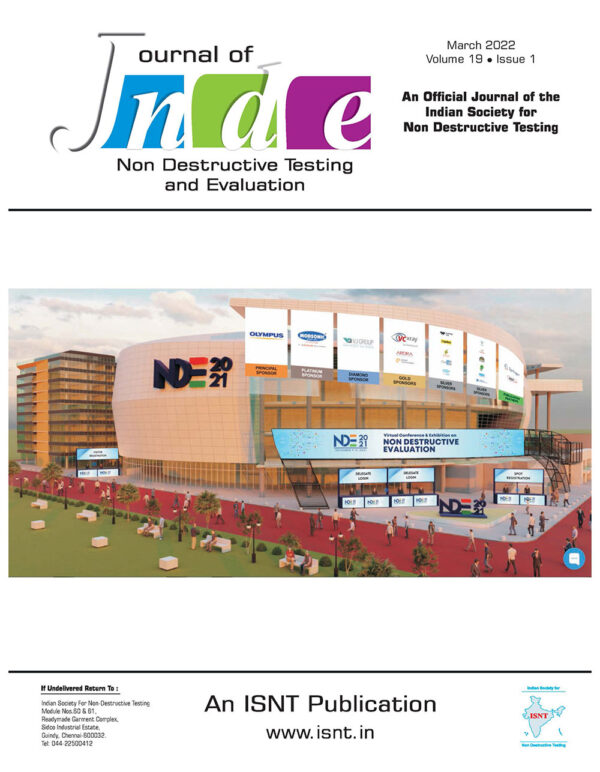
Published 20-03-2022
Keywords
- SHM,
- Fiber Bragg Grating,
- Damage localization,
- Masonry,
- Arch
- Settlement ...More
How to Cite
Copyright (c) 2022 Journal of Non-Destructive Testing and Evaluation (JNDE)

This work is licensed under a Creative Commons Attribution-NonCommercial-NoDerivatives 4.0 International License.
Abstract
Almost all engineering disciplines face the problem of damage detection and assessment. Civil structures built in the past have suffered the consequences of extreme loading events, such as earthquakes, wind, impact etc., over long periods, often leaving them disjointed and degraded. Monitoring of these structures is the need of the hour. It has been observed in the past that the many of important infrastructures failed due to lack of maintenance. Repair measures can only be carried out if these structures are monitored and the condition of the structure is assessed properly.
This paper discusses a vital issue of monitoring of structures undergoing settlements. The test has been conducted on a brick masonry semi-circular arch which is subjected to settlement at one of its abutments. The variation of strains is recorded using Fiber Bragg Grating (FBG) optical sensors at three locations on exterior face of the arch. The strain profile obtained exhibits the necessity of SHM in structures since the sensors are able to monitor the variations which are not noticeable and are obligatory to assess the safety of any structure.
References
- F. Palmisano and A. Elia, “Masonry buildings subjected to foundation settlements due to landslide: A preliminary study on the interpretation of structural behaviour using the load path method,” in WIT Transactions on the Built Environment, 2009, vol. 109, pp. 141–150, doi: 10.2495/STR090131.
- R. Landolfo et al., “Rigid block and finite element analysis of settlement-induced failure mechanisms in historic masonry walls,” Frat. ed Integrita Strutt., vol. 14, no. 51, pp. 517–533, 2020, doi: 10.3221/IGFESIS.51.39.
- A. Iannuzzo et al., “Modelling the cracks produced by settlements in masonry structures,” Meccanica, vol. 53, no. 7, pp. 1857–1873, May 2018, doi: 10.1007/s11012-017-0721-2.
- P. Zampieri, F. Faleschini, M. A. Zanini, and N. Simoncello, “Collapse mechanisms of masonry arches with settled springing,” Eng. Struct., vol. 156, no. February, pp. 363–374, 2018, doi: 10.1016/j.engstruct.2017.11.048.
- J. M. W. Brownjohn, “Structural health monitoring of civil infrastructure,” Philos. Trans. R. Soc. A Math. Phys. Eng. Sci., vol. 365, no. 1851, pp. 589–622, 2007, doi: 10.1098/rsta.2006.1925.
- H. Alexakis, A. Franza, S. Acikgoz, and M. DeJong, “Structural health monitoring of a masonry viaduct NDE2020, 060, v1: ’Monitoring of Settlement in Masonry Arch using FBG Sensors’ 7 tech paper 30 March www.isnt.in 2022 Journal of Non Destruction Testing & Evaluation with Fibre Bragg Grating sensors,” IABSE Symp. Guimaraes 2019 Towar. a Resilient Built Environ. Risk Asset Manag. - Rep., no. March, pp. 1560–1567, 2019.
- M. G. Masciotta, A. Barontini, L. F. Ramos, P. Amado Mendes, and P. B. Lourenco, “An Overview on Structural Health Monitoring: From the Current State-of-the-Art to New Bio-inspired Sensing Paradigms,” Int. J. Bio-Inspired Comput., vol. September, no. 1, p. 1, 2018, doi: 10.1504/ijbic.2018.10020764.
- O. Avci et al., “Wireless and real-time structural damage detection: A novel decentralized method for wireless sensor networks,” vol. 424, pp. 158–172, Jun. 2018, doi: 10.1016/j.jsv.2018.03.008.
- R. L. Crane, “Introduction to structural health monitoring,” Compr. Compos. Mater. II, no. March, pp. 355–357, 2017, doi: 10.1016/B978-0-12-803581-8.10350-9.
- V. G. M. Annamdas, “Review on Developments in Fiber Optical Sensors and Applications,” Int. J. Mater. Eng., vol. 1, no. 1, pp. 1–16, 2012, doi: 10.5923/j.ijme.20110101.01.
- R. Marsili, G. Rossi, and E. Speranzini, “Fibre bragg gratings for the monitoring of wooden structures,” Materials (Basel)., vol. 11, no. 1, 2017, doi: 10.3390/ma11010007.
- B. Glisic, D. Inaudi, D. Posenato, A. Figini, and N. Casanova, “Monitoring of heritage structures and historical monuments using long-gage fiber optic interferometric sensors - an overview,” Proc. 3rd Int. Conf. Struct. Heal. Monit. Intell. Infrastruct. Struct. Heal. Monit. Intell. Infrastruct., pp. U927–U933, 2007.
- H. F. Lima et al., “Structural health monitoring of the church of santa casa da misericórdia of Aveiro using FBG sensors,” IEEE Sens. J., vol. 8, no. 7, pp. 1236–1242, 2008, doi: 10.1109/JSEN.2008.926177.
- B. A. Sundaram, K. Kesavan, S. Parivallal, A. K. F. Ahmed, and K. Ravisankar, “Monitoring of FRP strengthened concrete structures using FBG sensors,” Procedia Eng., vol. 14, pp. 1549–1556, 2011, doi: 10.1016/j.proeng.2011.07.195.
- A. M. Aizzuddin, Z. M. Hafizi, L. V. Kee, E. Vorathin, and K. S. Lim, “Development of Fibre Bragg grating (FBG) dynamic pressure transducer with diminutive voltage inconsistency,” IOP Conf. Ser. Mater. Sci. Eng., vol. 257, no. 1, 2017, doi: 10.1088/1757-899X/257/1/012080.

